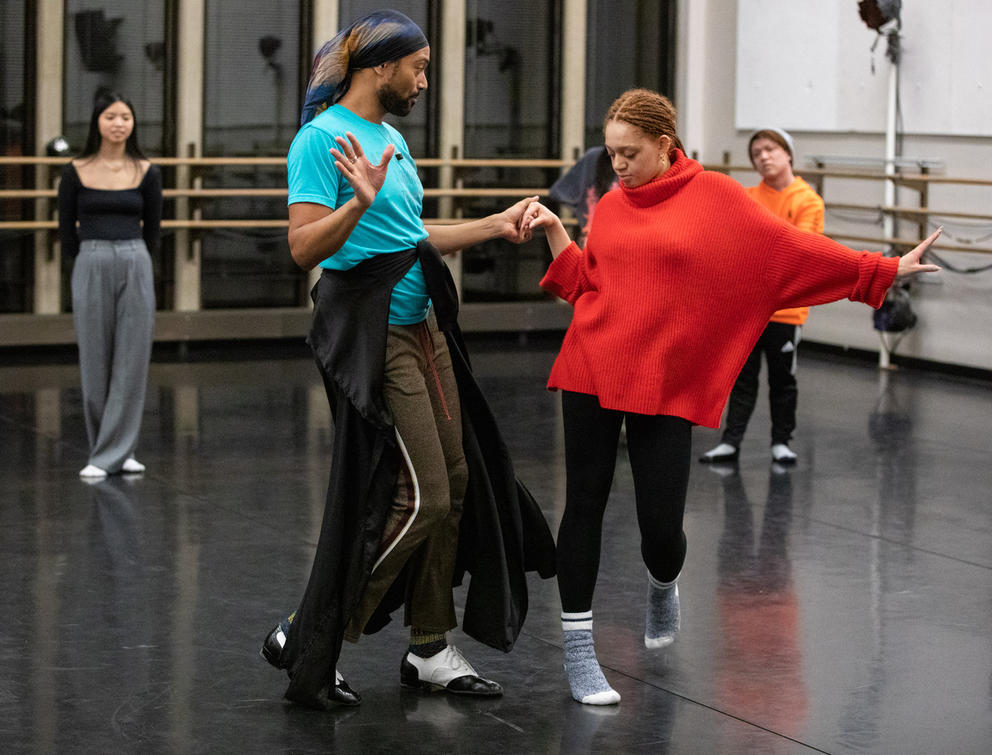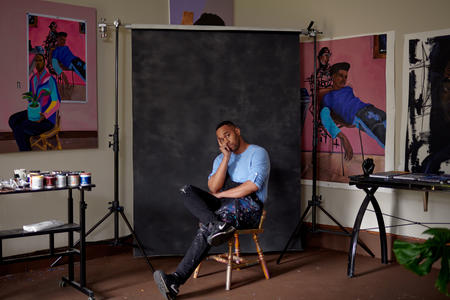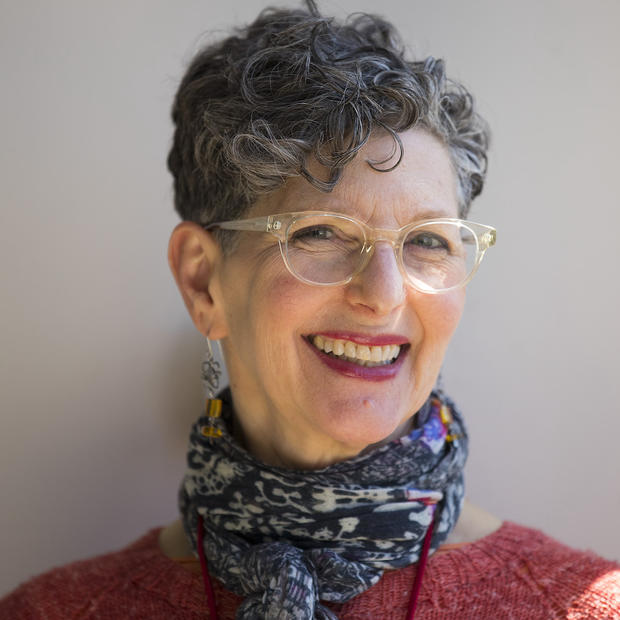And compared to the other arts programs, the dance department is small, with only five full-time teaching faculty and approximately 70 undergraduate students. Despite its size, the program is in the vanguard of a national movement to open academia’s ivory towers to both a broader range of coursework and a wider diversity of students.
Starting this past fall quarter, UW’s dance department is offering a revamped list of course offerings and a new set of requirements for aspiring dance majors — one that deprioritizes Western and European dance forms. The department also has opened its doors to any undergraduate who wants to learn how to dance, no experience necessary.
That’s rare in an arena where credentials are king, and in an era when STEM programming is often prioritized over liberal arts initiatives.
“I think the thing we’ve done that’s really different is bring in this idea that anyone can be a dance major,” says Associate Professor Rachael Lincoln, one of the departmental forces behind the overhaul. “We want the kid who grew up dancing with his mom in the kitchen, we want the kid who saw a dance show and was blown away.”
A modern collegiate dance program, as Lincoln envisions it, should offer equal space for hip-hop and folk dancers as well as leotard-clad ballerinas.
Because the intent isn’t to train prospective dance professionals, the UW offers a Bachelor of Arts (BA) rather than a Fine Arts degree (BFA). That’s been the case from the program’s inception in 1965, when it was part of UW’s Physical Education department. But even after it established its independence in 1988, the dance program wasn’t solely focused on churning out performing artists.
By contrast, across town, Seattle’s Cornish College of the Arts offers a BFA in dance with the expressed intent of producing working dance artists — performers and choreographers. Aspiring Cornish students are admitted through an audition process; that’s not the case at UW.
Even though the UW dance program hasn’t had the same dance-career focus as Cornish, the big change starting this academic year is that the faculty are courting students who want to study dance and also, say, neuroscience or history.
Department faculty believe dance — and the arts in general — can and should play a significant role in a general liberal arts education. According to dance department chair Christina Sunardi, the idea is to create a program “that uses dance as a lens to understand knowledge production, to gain skills that you use out in the world.”
To that end, UW dance majors are required to take introductory classes in at least four different dance genres before concentrating in any particular form. These aren’t just theoretical lessons; dance students learn and practice salsa, tango or hip-hop in addition to ballet and Western modern dance.
With just one academic quarter under its belt, it’s too soon for the dance department to judge the success or failure of its grand new plan. Lincoln acknowledges that the majority of undergraduate students still gravitate to modern dance and ballet courses. And there hasn’t yet been an influx of BIPOC dance majors. Nevertheless, she and her colleagues are certain they’re on the right path — but it has been long, winding and not without significant obstacles.
The decision to revamp the program and open it to the wider student body wasn’t easy or simple. Lincoln and her fellow department faculty members began contemplating major changes four years ago, before George Floyd’s 2020 murder sparked intense conversations about racial justice and diversity at universities across the country.
First, the faculty solicited input from students. Then they set out on what became a two-year trek to reframe the undergraduate degree.
Although other academic programs at UW also have been re-examining their curricula with the same goal of making them less Eurocentric, the dance department overhaul proved problematic to the wider University community.
Traditionally, majoring in any academic discipline means the student is focused on achieving specific mastery of a particular subject; they start with 100-level courses and work their way through higher-level offerings. Making any changes in those offerings, even to a course title, requires approval from a gauntlet of campus-wide committees.
And when the dance department first presented its proposed changes, some of those committee members wondered what it would mean for the notion of mastering a subject if the department allowed students to dip in and out of a wide array of offerings.
“The science brains were saying, ‘Well, if somebody is a dance major, they have to show mastery,” says Lincoln. “And we had to explain again and again that mastery comes in different ways that have nothing to do with the class level.”
The dance faculty, along with many other educators, believe studying an art form imparts discipline as well as critical-thinking skills — assets that transcend the practice of the art form itself. And the physical skills dance provides prove useful beyond the field as well. “Why not send people into the job market with bodies that trust themselves, with an awareness of space and perspective?” Lincoln says.
In addition, she and her colleagues argue that exposing students to a wide array of cultures, as seen through the lens of dance, has the extra benefit of meeting the UW’s campus-wide goal of diversifying curricula.
Lincoln and fellow dance professor Juliet McMains pleaded their case repeatedly, then incorporated the feedback they received from the various campus committees. Ultimately, the department successfully revamped more than 30 courses, and, when possible, created a traditional progression of classes in areas like African dance, Salsa and Tango.
Even before the various committees gave their final blessings to the reconceived major, at least one prospective graduate student was attracted to the UW dance program thanks to national word-of-mouth about the proposed changes.
Abdiel Jacobsen learned about the UW program innovations from a mentor at the University of California-Irvine, who recommended it when the young dancer expressed interest in researching gender roles in club dances, specifically Latin Hustle.
“That was a big door opener for me,” Jacobsen says. “I know that, traditionally, what I would research would not be represented or supported. I was like, ‘OK, I can see myself coming here.”
Unlike the undergraduate dance program, the UW Master’s of Fine Arts program, established in 1990, is aimed specifically at professional dancers who want to teach at the college level; it wasn’t directly included in the department’s curriculum update. However, the program’s six graduate students are required to teach undergraduate courses, so they’re an integral part of that program.
Now one of those six graduate students, Jacobsen never considered any other universities, even though UW isn’t the only large academic dance program rethinking what and how it teaches.
Lincoln and department chair Sunardi point to programs at the University of Florida and the University of California’s various campuses, including Irvine, as role models for UW. The University of Florida teaches a series of courses in African and African diasporic dance traditions; UC-Irvine offers instruction in what it calls “selected world dance forms,” as well as tap and hip-hop.
“I’d like to think we’re leading something, you know, but that could just be me wanting to be proud of our department,” says Sunardi. “Where we’re really being kind of radical is in not insisting on the levels in technique classes, not requiring that students get to a certain level in technique in order to get the BA.”
The dance department’s curriculum update might have seemed radical to campus members outside the program, but some local dancers don’t believe it goes far enough.
Seattle-based choreographer and dance scholar Nia-Amina Minor, who studied at both Stanford and UC-Irvine, acknowledges that changing degree requirements is notable, but sees more room for improvement.
“I think it’s crucial that young dancers are immersed in movement languages that reflect the world we live in. The global majority is not white/European,” Minor wrote in an email. “But how is this shift reflected not just in coursework but also in the culture of the department? Where are the students and teachers whose voices have been historically exploited and underrepresented?”
That’s one of the UW dance program’s big challenges; the majority of its permanent teaching faculty are white, so the department relies on a diverse group of adjunct instructors and graduate students to bring different cultural backgrounds and perspectives to the classrooms.
This quarter Jacobsen is teaching a course called Street Styles, featuring instruction in club dances including the Hustle. (With roots in salsa and mambo, the Hustle was popularized by Puerto Rican Americans in New York in the 1970s and has continued to evolve.)
Jacobsen, who learned the Hustle in New York clubs during their off hours from a full-time gig with the Martha Graham Dance Company from 2011 to 2018, believes the Hustle is accessible to everyone, from dance neophytes to competition dancers.
“I would say half my students — at least half — have never danced before. And they’re able to be in the classroom with people who are trained and have been dancing for years,” says Jacobsen. “I love that there’s always a mix of students, with different perspectives. It’s like a microcosm of the world.”
Jacobsen is one of four nonwhite grad student instructors; the department also has a half dozen part-time and adjunct faculty of color. The UW’s current full-time teaching faculty are not only majority-white; they come mainly from Western dance backgrounds (ballet and modern). That means the dance department needs to recruit a diverse cadre of graduate students like Jacobsen to maintain a wide array of studio classes.
And that’s another challenge, because the department mainly has recruited grad students from the professional dance world; yet many professional dancers — those who joined dance companies via auditions or through full-time professional dance training programs — don’t have the required undergraduate degree to enter UW’s MFA program.
“There’s this beautiful desire to have inclusivity,” says Jacobsen, who has a BFA as well as experience with the Martha Graham Company. “But those people who have dedicated their lives to the practice [of dance], who can teach at this level, they weren’t represented in the academic structure historically. So how do we open the door and say ‘We want you’ when they don’t have an access point?”
For Jacobsen, the UW dance program’s efforts to broaden curriculum and welcome a wider array of students are just baby steps toward making academia more relevant in an age when most information can be accessed with a few mouse clicks, classes can be taught via Zoom and new AI software can write college essays.
“What are people going to come here for?” asks Jacobsen. “I’m arguing it’s human connection. How do we become human, how do we use our body, our senses, to communicate humanity? I think that’s the new landscape of academia.”
Listen to reporter Margo Vansynghel discuss this story on the Crosscut Reports podcast:
Get the latest in local arts and culture
This weekly newsletter brings arts news and cultural events straight to your inbox.











